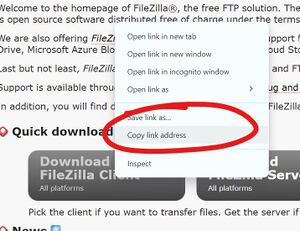Transfer Data
Overview
This document describes transferring data between a local computer (client) and HiPerGator (HPG). For file sharing on the cluster see Sharing Files
- Note: ResVault users: find more info in this page
Tools
There are a variety of command-line, GUI, and even web-based tools available for transferring data to or from HiPerGator. Command-line tools include, for example, 'cp, mv, scp, rsync, sftp, wget, curl, or ncftp (from the ncftp environment module]'. GUI tools like Cyberduck, WinSCP, BitVise SFTP and similar tools can be used on your local computer. Globus data transfer tool is available via a web interface in addition to command-line and GUI versions that can be run on your local computer. Please visit the HPG how-to video series on Data Transfer for more details.
Transferring Data within HiPerGator
Login servers on HiPergator (hpg.rc.ufl.edu) can be used for rsync, copying files with cp or mv depending on the group configuration and permissions or filesystem ACLs (extended permissions). There is a shared directory at /blue/GROUP/share for groups that prefer to share their data between group members. See also: Shared Work and Storage Management, Sharing Within A Cluster
Transferring Data Outside of HiPerGator
Between a local computer and HiPerGator
Open OnDemand
Open OnDemand has file management tools to transfer files (less than 20Gb at the time). See Open OnDemand for details
Globus
If your data files are large (hundreds of megabytes or gigabytes) then try Globus first.
Samba
Samba is a Linux server that provides remote filesystem access using SMB/CIFS protocol. See Samba Main Wiki Page for more info.
SFTP/Rsync
For smaller file sizes, or if Globus is not an option, use SFTP/rsync/scp by connecting to the 'hpg.rc.ufl.edu' or 'sftp.rc.ufl.edu'. Set port to 22 if you have to specify it. Use your gatorlink credentials to connect. Make sure MFA (multi-factor authentication) is taken into account to avoid having to go through MFA for every file transferred. You can also use terminal interfaces like BitVise, which include an GUI SFTP function embedded.
- Note
- If you are using Cyberduck on a MacOS computer and notice that it is using the old password resulting in a security lockout uncheck 'Use Keychain' in 'Preferences > General'.
Rclone
Rclone is a command-line data transfer tool that support transferring data from or to dozens of cloud storage providers and remote locations. Please see https://rclone.org/docs/ for information on a specific storage provider.
JupyterHub
The easiest way to upload data using JypyterHub is by using the Upload Files button included in the File Browser (Ctrl+Shift+F) menu.
From HiPerGator to a remote system/site
If you are logged into HiPerGator and need to transfer data to or from a remote system or a site use the login nodes. Transfers can also be made from within developmental sessions. You can use ftp (lftp command), sftp, scp, rsync, or Globus to transfer data out.
Downloading Data from an External Server or Third-Party Website
Terminal: wget or curl
In most file managing websites, the "Download" buttons have the option to right-click and select an option similar to "Copy link address".
Once the link address is copied in the clipboard, you can paste it in your HPG terminal following your "wget" or "curl" commands, such as:
$ wget https://github.com/author/software/main.zip"
Internet Browser from HPG Host
Another option is to use the Firefox or Chrome browsers via Open OnDemand or an X11-based SSH session.
Start a X11 forwading-enabled SSH session or a terminal on a HiPerGator Desktop session on Open OnDemand:
1. From a HPG node, launch the module ubuntu, which contains a version of the Google Chrome browser.
- $ module load ubuntu - $ chrome (or firefox) The Internet browser should launch.
2. Navigate and login to the third-party service, such as Dropbox or Google Drive using your gatorlink account.
3. Edit the browser's download settings to change the Download location (path) to your preferred /blue directory.
4. Navigate to the target directory in your Drive account using the browser and select files or folders to download.
The files should download directly to your selected /blue path.
Download data to personal computer first
Alternatively, users can download files to their local computers and upload them into HPG using one of the methods described in the "Between a local computer and HiPerGator" section above.
Providing access to your data
If you need to share data with another RC user or publicly for collaboration, view instructions at Providing Access To Data

